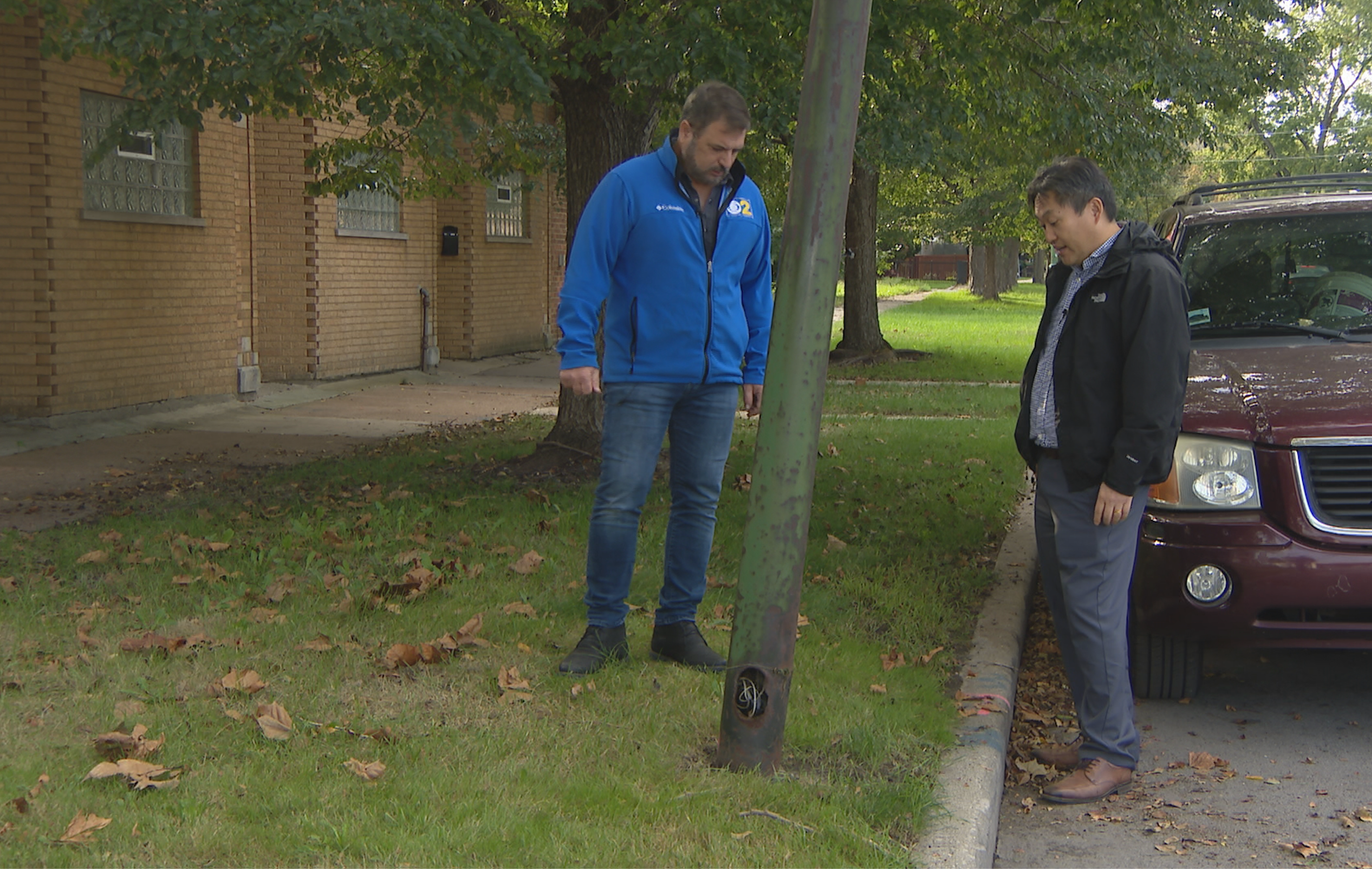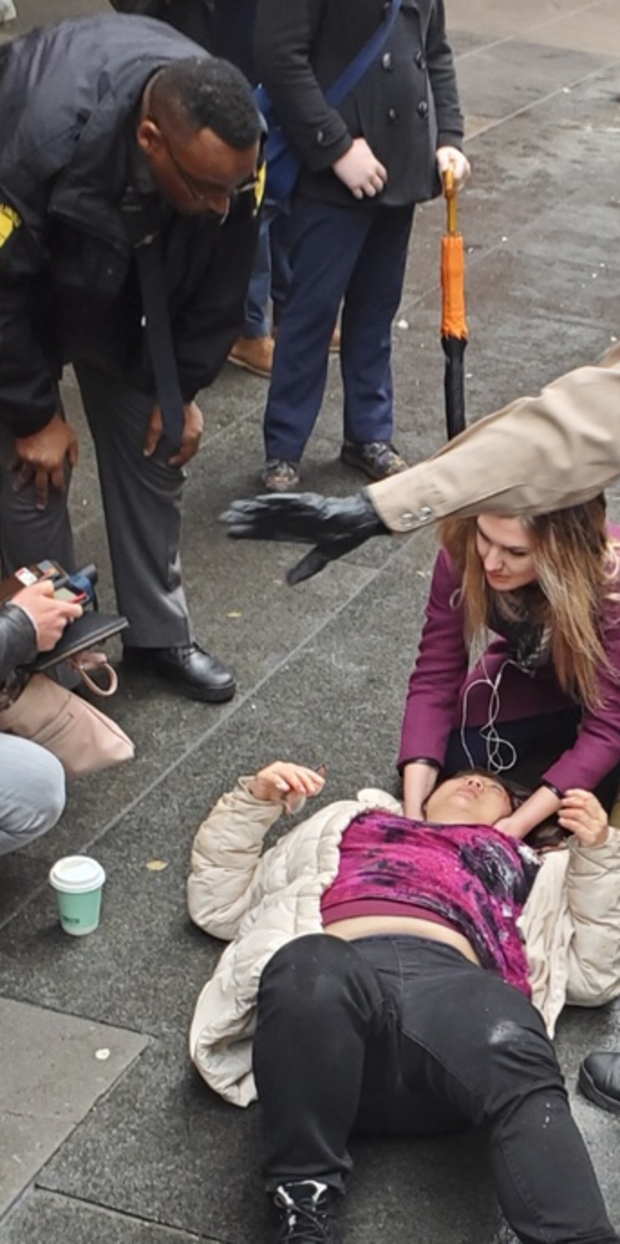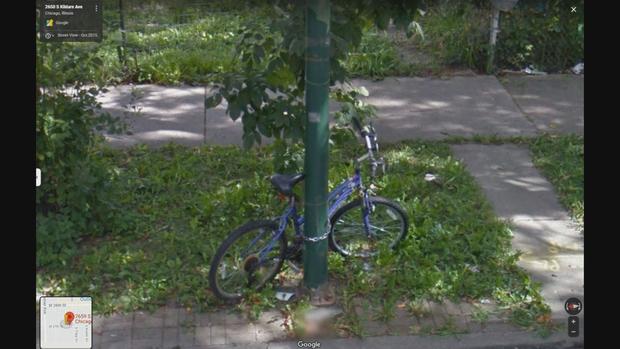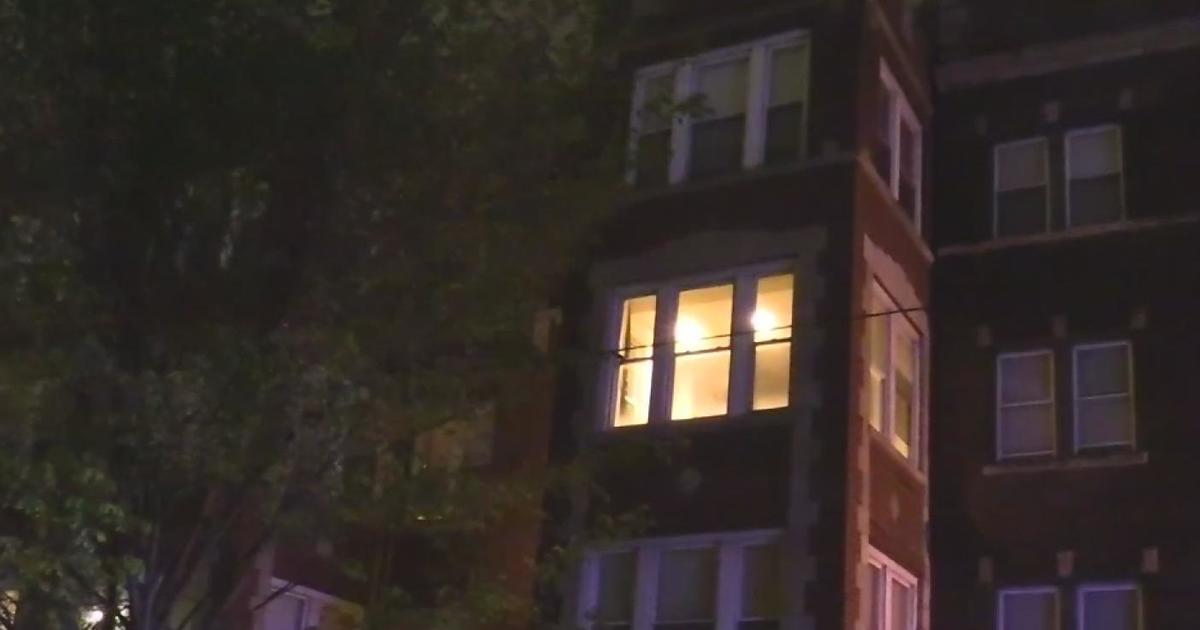City Was Warned About Thousands of Corroding Light Poles But Failed to Fix Many, CBS 2 Investigation Finds
By Dave Savini, Michele Youngerman, Samah Assad
CHICAGO (CBS) — It was 2007 when a light pole fell and hit 13-year-old Noni Brown in Chatham, injuring her spine.
In 2016, Lauren Lammy said she was lucky she wasn't there when a light pole snapped and smashed into her car in Old Town.
And just a few years later, in 2019, Maya Kirk was walking back to work after lunch in the Loop when she was struck by a light pole that had been quietly corroding for years. The impact shattered her femur and knee.
"I think I was in so much pain at the time…not a lot was registering at that moment," Kirk said in a previous interview. "But I was just thinking, 'That fell on me. How am I still here?'"
For the last six years, CBS 2 identified frightening examples of decayed poles that fell and injured residents, or caused damage, across the city. This includes hundreds of 311 complaints.
But for the first time, the public can now understand the scope of the problem. CBS 2 obtained and analyzed the findings of a CDOT-commissioned survey that graded every pole. We found the city department responsible for maintaining the infrastructure was warned about concerning poles, but it failed to repair or replace many of them. According to experts and residents, some of these poles are a danger to the community.
'A Scary Number'
There are more than 330,000 light poles that line Chicago's streets – all are integral to illuminating neighborhoods and keeping them safe.
At an Aug. 25 news conference, CBS 2 asked CDOT's First Deputy Commissioner Tom Carney how many poles needed to be replaced immediately.
"We definitely have prioritized the worst of the worst," Carney said, adding he didn't know the number.
"I'll have to look at the data," Carney said.
To understand the condition of every pole, CDOT hired a sub-contractor to visually inspect each one in 2017 and 2018. The survey cost more than $2.5 million and was conducted as part of the city's Smart Lighting Project, according to city records.
Auditors provided each pole with a rating or grade across multiple categories, including rust, lean, general damage, and damage to the anchor bolts. Ratings range from describing poles as having no observed issues to major problems.
CBS 2 obtained the raw data of the study – the closest thing the public has to help understand the state of light poles in the city.
Of the 330,000 light poles in the city, more than 33,000 poles, or 10 percent, were graded as having some sort of serious issue across all four of the major categories, our data analysis found.
"That's a scary number," said Dr. Sammy Tin, formerly a professor at the Illinois Institute of Technology. "Aging infrastructure, deferred maintenance are tremendous issues – not just in Chicago, but across the country."
Tin, a metallurgist, now heads up the University of Arizona Materials Science and Engineering Department. He's spent years visually examining Chicago's light poles.
He said rust is often a key indicator of a deeper problem with the integrity of the pole. More than 22,000 poles were rated as having a concerning amount of rust, the data shows.
CDOT spokesperson Mike Claffey said the study was a starting point to identify and target deteriorating poles. Approximately 1,650 have been replaced as a result.
But CBS 2 visually reviewed hundreds of poles for this report and found many that received low ratings at the time of the study have not been repaired or replaced and are still in a deteriorating state today.
One of those is on the 2700 block of East 92nd Street in Chicago's Calumet Heights neighborhood. In 2017, the auditors documented it had major damage, rust and leaning. It's still there today.
"Four years later and it's still here," Tin said when he reviewed the pole. "This is a light pole that needs to be fixed immediately…it certainly has a high probability of falling over in the future."

Clearly leaning and riddled with rust today, the pole is a hazard that stands in front of James Garland's home.
"They need to fix it," Garland said of the city. "…It's disappointing to look at, you know. But if they're not going to fix it, we can't do anything but worry about it."
Scott Kibler rides his bike past a corroding pole in the Mount Greenwood neighborhood on the 10800 block of South Longwood multiple times a day.
The city's study said that pole had a concerning amount of rust at the time it was surveyed in 2017. But it hasn't been replaced.
"I would love to see it replaced," Kibler said. "Something safe, modern and just sound. I wouldn't want any accidents to happen."
'It's About Public Safety'
Garland and Kibler aren't alone in their worries about deteriorating poles in their communities.
Deborah Chester has lived on Wentworth Avenue in Roseland for more than 20 years. She's concerned a light pole riddled with holes and rust on her street could fall over.
What Chester didn't know is that her community was also among those impacted the most by bad poles at the time the survey was done.
CBS 2 mapped the locations of the more than 33,000 poorly rated light poles and found Roseland was riddled with 1,118 that were deemed concerning – the most of any neighborhood.
"The way this pole is so rusted out at the base, it could topple over on to a house, a car, or even a person walking up and down the street," Chester said.
This map shows a breakdown of the total number of concerning light poles by neighborhood. Map by Samah Assad/CBS 2.
In addition to Roseland, the communities with the most problem poles include:
- Norwood Park: 947
- Ashburn: 860
- Portage Park: 843
- Englewood: 797
Among the 947 badly rated poles in Norwood Park, CBS 2 found one on North West Circle Avenue is still standing near Norwood Park Elementary School – despite being rated as having a major lean, major damage and a concerning amount of rust at the time of the study. An auditor also noted damage to the pole's anchor bolts, which are critical to keeping it secure.
"Anchor bolts buried," the auditor wrote in the survey.
CBS 2's extensive analysis of the city's data also raises questions about the accuracy of the survey.
On Oct. 24, a light pole in Little Village snapped at the base and nearly hit children walking on the sidewalk, community activist Raul Montes, Jr. said.
"I mean, what if it would've hit them?" Montes, Jr. asked. "Somebody would've probably got killed."
But back in 2017, auditors did not raise a red flag about this pole. Instead, they said it had a "routine" amount of rust. That's despite Google Street View images showing the pole has been rusted at its base dating back to 2015.
"Somebody needs to be held accountable," Montes, Jr. said. "I mean, this is about public safety."
In November of 2019, Maya Kirk was struck and severely hurt by a light pole while walking in the loop.
"The thing is, these poles can kill somebody," said Kirk, who filed a lawsuit against the city. "And I just – I'm lucky to be alive."
But nearly two years earlier, the survey didn't document any major problems with the pole. Instead, it was rated it as having a "routine" amount of rest with no damage, the study said.
"It tells you a little bit about the degree of detail and depth associated with some of these surveys," Tin said. "Some of these surveys are very quick, visual, drive-by type surveys."
Best Practices
Tin said there are multiple factors that could explain why poles were graded inconsistently. This includes pole conditions changing over time, potential inadequate training given to the auditors, or the auditors failing to comprehensively review and document the damage during their visual check.
"I imagine most of the inspections were done in a drive-by manner," he said. "Probably just drove by, took some pictures and moved on to the next pole."
If you have any issues to report about the city's light poles, tell us here.
Tin said while a visual inspection is a solid starting point, it isn't sufficient for a city to understand the true extent of the problem. Often, damage to a pole can be worse than it appears. With Chicago's cold climate and the way the poles are designed, trapped moisture and salt can lead to hidden corrosion.
"If you really want to know the condition of the poles, you have to do a full scale [inspection]," Tin said. "It takes a little bit of time."
That includes removing the covers to inspect the worst poles more thoroughly. A full inspection for one pole could take up to an hour.
"If there's significant rust, a visual inspection won't fly," Tin said.
"There should've been follow-up," he added. "...and identification of the poles that have the highest likelihood or probability of failure."
CDOT did not provide specific details when asked how the department formally prioritizes fixes, replacements and in-depth inspections for poles.
CDOT also denied CBS 2's multiple interview requests with Commissioner Gia Biagi but provided a statement, which said, in part:
- The study resulted in the replacement of approximately 1,650 light poles identified in the survey
- Separately, from 2018-2020, approximately 4,170 new streetlight poles were installed as part of the residential and arterial pole replacement programs, including 2,700 of those on residential streets and 1,470 on arterial streets
- CDOT is aiming to replace about 2,500 poles in 2022
When sent the addresses of problem poles identified by CBS 2, a spokesperson also said some poles mentioned in this report will be slated for fixes or replacement. For example, there is now a red warning ribbon on the Norwood Park pole mentioned in this story, and the ground has been marked for gas and electric lines – clear indications it will be replaced soon. You can read CDOT's full statement here.
It's still unclear how many of the 33,000 badly rated poles CBS 2 identified have been, repaired, replaced, or slated for replacement.
Experts acknowledge it's expensive and time consuming to inspect and fix deteriorating light poles. But Tin added it's critical for cities to invest in infrastructure by maintaining poles on a routine basis. The goal: to prevent the acceleration of rust and decay, and keep communities safe.
"As a city, as a state, as a country," Tin said, "we need to do more in terms of investing in aging infrastructure and replacing and servicing when needed."
Read our methodology and how we reported this story here.
Contact Us
The CBS 2 Investigators will continue to report on problems with the city's infrastructure. If you or someone you know has been hurt by falling light poles or other damaged infrastructure, contact us by filling out the form below.
[contact-form to="mayoungerman@cbs.com, dvsavini@cbs.com, cmhacker@cbs.com, sfassad@cbs.com"][contact-field label="Name" type="name" required="1"][contact-field label="Phone Number" type="text"][contact-field label="Email" type="email" required="1"][contact-field label="Message" type="textarea"][/contact-form]
CDOT provided the following statement:
Thanks to Mayor Lightfoot's Chicago Works capital plan, the City of Chicago is accelerating its investments in new streetlight infrastructure and has more than doubled the number of streetlight pole replacements carried out annually. The program is providing the Chicago Department of Transportation with $112 million in dedicated funding in 2021 and 2022, more than double the amount of funding from previous years.
Over the two years, CDOT will be installing more than 7,000 new streetlight poles. This includes 1,950 new poles on residential and arterial streets this year through our existing streetlight pole modernization programs, with another 2,900 poles to be replaced in 2022 programs. In addition, CDOT is leveraging Chicago Works funding to launch an aggressive new program to identify and replace poles that are showing signs of deterioration. This new effort is aiming to replace about 2,500 poles citywide in 2022.
That is the bottom line – and the claim in your story that 33,000 are dangerous and can be characterized as "worst of the worst" is not only inaccurate but irresponsible.
These robust new investments in streetlight poles have come as CDOT is nearing completion of the Chicago Smart Lighting Program (CSLP). While the primary goals of the project were to modernize our streetlight system and to improve the reliability and quality of Chicago's outdoor lighting and reduce electricity costs and our carbon footprint, we also took the opportunity to assess the condition of streetlight poles and wiring to make targeted repairs and replace poles and wiring where needed.
By switching to LED lights from outdated High Pressure Sodium fixtures, Chicago taxpayers are expected to save $100 million in electricity costs over ten years –in addition, the program has generated more than $32 million in energy efficiency rebates for switching from outdate High Pressure Sodium fixture to state-of-the art LED streetlights.
At the start of the CSLP in 2017, CDOT conducted a citywide asset condition survey of the more than 300,000 streetlights in our inventory. The survey consisted of a visual inspection of each streetlight pole in our inventory and resulted in the replacement of approximately 1,650 poles by the CSLP team. The survey was a first step in the process of identifying poles that were showing signs of deterioration.
CBS 2's response:
After CBS 2's morning story ran, CDOT added this statement: "That is the bottom line – and the claim in your story that 33,000 are dangerous and can be characterized as "worst of the worst" is not only inaccurate but irresponsible."
Since July, CBS 2 has been trying to get CDOT officials to answer questions about the survey and concerning findings of light poles with rust, leaning, or damage.
CDOT officials waited until late today to send an email saying only about 150 light poles were of major concern, those, "met the following criteria: major rust, major lean and major damage". But, in that same e-mail, the spokesperson confirmed the 33,000 poles, "were rated as having "concerning levels" of rust or leaning or damage."
It is those concerning levels of decay we have been reporting on since 2015, especially rusting poles which could potentially fall.
When we asked CDOT for records about follow up inspections on the concerning poles, they could not produce any. They also could not provide any records on how they prioritize maintenance or replacement of these concerning light poles.
The city maintains the vast majority of light poles are safe. Thousands of new poles are slated to be installed.





